Teaching loose leash walking
by Ontario SPCA and Humane Society | Dog Care | April 26, 2022

Walking politely on leash can be one of the most challenging behaviours to teach a dog. The good news is that by gaining realistic expectations about your dog’s exercise needs and following some simple training techniques, you and your dog can develop wonderful walking habits.
Walk, trot, romp, race
A walk is a wonderful social outing for you and your dog. It provides a great source of smells and mental stimulation and it`s a great way to work on training your dog to respond to requests despite distractions.
However, it is not adequate exercise for most healthy, high-energy adolescent or adult dogs. Most dogs consider our slow plodding steps around the neighbourhood to be quite boring, and sometimes resort to making their own excitement by lunging or barking. This can be accentuated when they are spending long periods at home without activity, and then are restrained at the end of a leash for a brief outing outside. To take the “edge” off your dog’s energy, add a healthy mix of additional mental and physical exercise to your dog’s life, including indoor games, supervised play sessions with other dogs (if appropriate), and games of fetch in the backyard.
Train, train, train, train
Using the phrase “Let’s go!” means your dog can walk a little ahead, behind, or to the side of you, stop, sniff, pee and explore – as long as he doesn’t pull the leash. Follow the steps below to teach your dog that walking politely at your side is rewarding.
Note: To “mark” good walking, pick a sound you’ll consistently use to tell your dog that he or she has earned a reward and a treat is coming. The verbal marker “Yes!” or clicker marker (a small plastic box that makes a “Click!” when pressed and is available at pet stores) are popular choices.
- Hold the leash in your hand with your dog sitting on the same side. Hold tasty treats in your other hand, hidden from your dog. The leash should be loose enough so that it remains slack if your dog walks a few paces ahead or to the side of you.
- Say “Let’s go!” in a cheerful voice and start walking. As soon as he begins to walk forward with you, say “Yes!” (or “Click!”), then deliver a small, tasty treat (at your knee). At first, say “Yes!” and treat often; almost every step. When your dog is watching you attentively, gradually reduce how often you say “Yes!” and treat.
- As your dog gets good at this game, gradually reduce the rate you say “Yes!” and treat. Be sure to say “Yes!” and treat randomly (for example, the fourth step, second step, tenth step, fifth step). If your dog knows they are going to get rewarded every tenth step, he can quit paying attention for nine steps, and refocus on the tenth. Be careful not to reduce the rate of reward too quickly or your dog will get frustrated and lose the behaviour. Also, make sure you’re not pulling your dog (which can make your dog anxious and cause him to pull).
Troubleshooting
Key to teaching polite walking is preventing yourself from “accidentally” rewarding your dog for pulling. This occurs each time you allow him to pull forward and successfully sniff something or greet someone. Below are techniques to help keep your training on track.
If you are approaching a distraction…
> Use a lure.
When you have to pass a very tempting distraction, use a treat briefly to lure your dog past the distraction. Put a tasty treat at the end of their nose (use tastier treats for higher distractions) and walk him or her past. Your need for luring will lessen as your dog’s polite walking improves.
> Give the cue for “Watch.”
The instant your dog looks at a tempting distraction, for example another dog, say “Watch” and wave a smelly piece of food an inch away from your dog’s nose to get his attention. Bring the hand with the food up toward your face to lure your dog’s eyes up to yours. You can also click your tongue or smooch to encourage your dog to look up at you. When you get eye contact, say “Yes!” and treat as you move in the opposite direction of the distraction.
Check out this training video for additional tips to teach Watch me.
If your dog starts to pull in front of you…
> Do a U-turn.
When your dog starts to move out in front of you, before he gets to the end of his leash, turn around and walk in the opposite direction (do this gently). As you turn, call out “Turn” in a cheerful tone or make a kissy sound to let him know you’ve changed direction. When he turns to come with you, say “Yes!” and offer a treat behind your knee.
If your dog pulls ahead of you on a tight leash…
> Play “Be a tree.”
When the leash tightens, stop walking, stand still and wait without giving any cue or corrections to your dog. Eventually he’ll wonder why you’ve stopped and look back at you or move closer to investigate. The instant the leash loosens, say “Yes!” and feed him a treat behind your knee (he’ll have to return to your side to get it).
If “Be a tree” isn’t working add “Penalty yards.”
If he keeps pulling when you make like a tree, back up slowly with gentle pressure on the leash so he’s moving further away from his goal. This teaches him that his pulling makes the good thing go further way. When the leash loosens, say “Yes!” and treat, or move forward to the item he was interested in as his reward.
Helping your dog achieve success
There are times when you will be rushed (or distracted), or your dog is too energetic or overwhelmed by certain distractions for either of you to be able to practice your training walk successfully. In these instances, using a humane walking tool on your dog (such as a Halti/gentle leader or a harness) can help them be successful and also prevent your dog from regressing from his previous learning sessions.
It’s also helpful to recognize that dogs are hard-wired to sniff, and if you never allow them to do so they can become frustrated and aroused. Create a cue you use periodically, such as “Go sniff,” to give your dog permission to investigate a particularly exciting smell, a person they want to visit, or a dog they want to greet (provided it’s appropriate to do so).
Initially, it’s best to practice in short sessions (5 to 15 minutes) and to end it while you’re having some success and both having fun (yes, walking should be enjoyable!). Dogs thrive on positive experiences and they repeat behaviours they find rewarding. If your dog learns that polite walking turns you into a treat dispensing machine and gives him the opportunity to walk and sniff comfortably, your dog will learn to walk happily at your side.
Categories
Testimonial
As an animal lover all the work you do
As an animal lover all the work you do to help ensure that every dog and cat can find their forever home that is filled with love is greatly appreciated.
